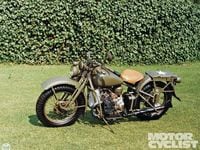Words: Aaron Frank
Photo" Harley-Davidson Archives
As reliable as it was, Harley-Davidson's WLA (see Icon, page 32) did suffer one major shortcoming: a high-maintenance chain drive. So when in 1940 the U.S. Army asked Harley to design a "next-generation" combat motorcycle, shaft drive—just like Nazi Germany's BMW R71—was a mandatory feature.
Operating on a compressed timeline, Harley’s engineers essentially copied the R71 powertrain piece-for-piece. “We just converted everything from millimeter to inch and built it,” Harley-Davidson production advisor John Nowak told military historian Bruce Palmer III. The resulting 750cc flathead Boxer-twin was mounted in a modified WLA chassis and the XA (for Experimental Army) was born.
The Army responded by awarding The Motor Company an initial contract for 1000 units in March of 1941. Though the XA more than satisfied the Army’s requirements, the contract wasn’t renewed, and no more XAs were ever built. The Defense Department decided that the less-expensive WLA would be sufficient for the military’s limited motorcycle needs, and instead invested heavily in a vehicle that was significantly safer, more versatile and easier for its soldiers to operate: the 4x4 Willys Jeep, which entered production in 1941.

/cloudfront-us-east-1.images.arcpublishing.com/octane/IN263JIBTBCD3O265IMSCW6OZM.jpg)
/cloudfront-us-east-1.images.arcpublishing.com/octane/SMAQ354X2JH7NJATXNSQY4NRS4.jpg)
/cloudfront-us-east-1.images.arcpublishing.com/octane/GGOH2AQRSVHY5C5JLNEVYLB5SU.jpg)
/cloudfront-us-east-1.images.arcpublishing.com/octane/TJJEHV3ATZFFXHUYZABHXKE2DI.jpg)
/cloudfront-us-east-1.images.arcpublishing.com/octane/WIC4RXQ36BAXNIW6U4UJ3XDLKI.jpg)
/cloudfront-us-east-1.images.arcpublishing.com/octane/B4PQZLY4LBHITGE5ZRRM2N5YNU.jpg)
/cloudfront-us-east-1.images.arcpublishing.com/octane/OBYS7KWZUJFCHD44YPTSVM5EF4.jpg)
/cloudfront-us-east-1.images.arcpublishing.com/octane/FY7ZXYBT4NH2NGYQIWQVITS4AM.jpg)
/cloudfront-us-east-1.images.arcpublishing.com/octane/JPET6WQUDZEYLNXVY5LRNDRPLA.jpg)
/cloudfront-us-east-1.images.arcpublishing.com/octane/EY6P2QIFQJCDTNOMR3JB7WJED4.jpg)
/cloudfront-us-east-1.images.arcpublishing.com/octane/V2U6JB7KXNCQRN4OW6HNJTVMZQ.jpg)
/cloudfront-us-east-1.images.arcpublishing.com/octane/AMS43BT5ABH77NY7XKLCSZCNM4.jpg)
/cloudfront-us-east-1.images.arcpublishing.com/octane/NTK2ASYKUBDW5MQDWQLVQYOELY.jpg)
/cloudfront-us-east-1.images.arcpublishing.com/octane/SX7R3KCIANGDBGF45O73F543TM.jpg)
/cloudfront-us-east-1.images.arcpublishing.com/octane/ZTW4V7RAPFG6RFWJRXR2IX5ZQ4.jpg)
/cloudfront-us-east-1.images.arcpublishing.com/octane/EPRSLPIUTBC5RPD7R263BPV2D4.jpg)
/cloudfront-us-east-1.images.arcpublishing.com/octane/EMJ4I2T4HVCRVJPZ3UJFVMRDHA.jpg)
/cloudfront-us-east-1.images.arcpublishing.com/octane/CBDAM3VMJNFDBLE7Y3FY7RD5BY.jpg)
/cloudfront-us-east-1.images.arcpublishing.com/octane/CCEB3TNMU5FH3OZ4FKJ7DA2LBA.jpg)
/cloudfront-us-east-1.images.arcpublishing.com/octane/VV6N3KUWEVFJJD7F7VX6ICOH7Q.jpg)
/cloudfront-us-east-1.images.arcpublishing.com/octane/R55SVEXZ5VA2LCWFWYR647ASX4.jpg)
/cloudfront-us-east-1.images.arcpublishing.com/octane/MYWIEFOQ6JCCNDR4OBF5PU5LVE.jpg)
/cloudfront-us-east-1.images.arcpublishing.com/octane/OOZ3C4GCUJGRNONDI6DHVM57GI.jpg)
/cloudfront-us-east-1.images.arcpublishing.com/octane/JEKB3CMWXZD6ZAVFEDKLOQ5FNY.jpg)